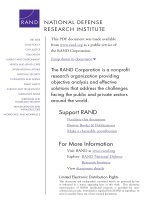Line balancing - Reasons To have balance the Production line
Bạn đang xem bản rút gọn của tài liệu. Xem và tải ngay bản đầy đủ của tài liệu tại đây (1.55 MB, 17 trang )
LINE BALANCING (Process
Organization)
Prepared by: Shaheen Sardar
BSc Texle Engineering
MS Texle Management
Line Balancing Garment
Manufacturing
LINE BALANCING (Process
Organization)
The Line Balancing is “to design a
smooth production flow by
allotting processes to workers so as
to allow each worker to complete
the allotted workload within an even
time”
LINE BALANCING (Process
Organization)
It is a system where you meet the
production expectations and you can
find the same amount of work in
process in every operation at any
point in the day.
Reasons to have balance the production
line
(1) Keeping inventory costs low results in higher
net income
(2) Keeping normal inventory levels lets the
operator work all day long giving him/her
the opportunity to earn more money by
increasing his/her efficiency
(3) Keeping the line balanced let’s the supervisors
improve other areas because they can use
their time better
(4) Balanced production keeps prices low which
turns into repeat sales
(5) Balanced production means better production
planning.
Balancing Tools
The most basic tools are
Production Sheets, the Daily
production report, the inventory
levels by operation and the
Production Boards.
How do we start balancing the
production line?
Well we can start by determining how many
operators for each operation are needed for a
determined level of production. After this we need
to determine how much WIP we need to anticipate
production problems. Recommended WIP is 1-
hour inventory level for each operation. A good
range would be from 30 min to 120 min inventory
level.
There are 3 rules for balancing:
(1) Have at least ½ hour of WIP for
each operation
(2) Solve problems before they
become any larger
(3) Meet production goals by
keeping every operator working at
their maximum capacity
Work In Process (WIP)
What is WIP?
WIP is made up of all garments and
their parts that are not completely
finished.
How can we manage WIP?
(1) Production planning
(2) Trims control
(3) Production Build-up
(4) Balancing
(5) Cut Flow Control
Balancing Matrix
LOW
WIP
HIGH
OUT PUT
LOW
Pitch Time
Reference value for
synchronization in the division of
labour is called Pitch Time (PT).
Pitch Time provides average time
allotted to each worker.
PITCH DIAGRAM
Bottleneck Process:
The time at which the longest time is required is called
“bottleneck Process”
The state of line organization should be evaluated as “Organization
Efficiency” Using the pitch time and Bottleneck Process Time.
Pitch Time
Organization Efficiency (%) = ________________________ x
100
Bottleneck Process Time
100
= ______ X 100
140
= 71.4 % (For the aforementioned case
study)
Pitch Diagram in the form of Bar
Graph
Work
Allotment
Time
How to reduce the number of
bottleneck processes
(1) Investigate the relation between the bottleneck
process and its previous and subsequent processes
to correct the line organization.
(2) Investigate whether it is possible to further divide
the process.
(3) Conduct the motion study for work improvement.
(4) Make improvements to equipment, jig and tools.
(5) Mechanize the manual work.
(6) Change the positions of workers.
(7) Investigate the modification to the machining
specifications.
(8) Make it a rule to lend the worker in charge of the
bottleneck process a helping hand
Control limit
Control limit
Pitch Time
Upper Limit = _________________________X 100
Target organization efficiency
= 0.85 = 117.6 Seconds
Lower Limit = 2 x Pitch Time – Upper Limit =
2 x 100 – 117.6 = 82.4 Seconds









